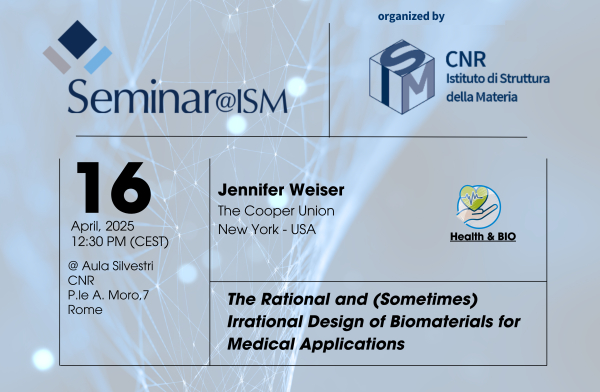The Rational and (Sometimes) Irrational Design of Biomaterials for Medical Applications Hip implants, synthetic heart valves, and drug eluting wafers for the brain. What do these all have in common? Each one is a biomaterial that is designed to interact with a biological system. Physicians often seek to cure ailments or improve a patient’s quality of life by employing biomaterials. Classically, the process of biomedical device innovation is driven by clinical demand in which a patient or physician defines a need, which provides a basis for an invention. Yet, it is here that the development of new biomaterials diverges. The first path to synthesizing a new biomaterial includes clearly defining a medical need and then rationally designing the material based on the need. This has resulted in the development of common products such as modern contact lenses and biodegradable surgical sutures. The second path involves developing unique materials that are biocompatible and do not elicit an immune response; however, these materials often do not have clearly defined medical applications or have failed in their original application. From this latter path, the material characterization and understanding of its inherent properties allows for the exploration of potential therapeutic biomaterials in irrational applications in which they were not initially intended. For example, our current rationally designed, modern contact lenses came about because one physician noticed that the eyes of his patients, who were WWII veteran aviators, had no long-term adverse effects from embedded pieces of shattered plastic windscreens from their fighter jets. As another example, the field of modern tissue engineering stemmed from one physician taking left over biodegradable surgical suture off the operating room floor post-surgery, fraying the threads, and growing cells on this 3D scaffold. This talk will cover the creation of biomaterials throughout the speaker’s career that were rationally designed for a specific medical application and then repurposed for a completely different, sometimes irrational, application.
Jennifer Weiser è Professoressa Associata di Ingegneria Chimica presso la Cooper Union for the Advancement of Science and Art, a New York City. La sua ricerca si concentra sulla somministrazione di farmaci, la guarigione delle ferite e lo sviluppo di biomateriali polimerici per applicazioni mediche. Ha conseguito la laurea in Ingegneria Chimica (B.S. 2006, Rensselaer Polytechnic Institute) e in Ingegneria Biomedica (M.S. 2010, Ph.D. 2012, Cornell University).
Nel settore industriale, ha lavorato come ricercatrice in chimica farmaceutica, occupandosi della ricerca esplorativa di nuovi composti terapeutici presso Wyeth Pharmaceuticals e come ricercatrice presso la startup iFyber, finanziata da un grant STTR dei National Institutes of Health (NIH).
Ha inoltre ricevuto una formazione post-dottorato tramite una borsa NIH Ruth L. Kirschstein NRSA in Ingegneria Biomedica (2014-2017, Università di Yale). Questo lavoro le ha permesso di ottenere un incarico come Visiting Assistant Professor nel Dipartimento di Chirurgia della Yale School of Medicine (2017-2018). Successivamente ha ricoperto il ruolo di Visiting Assistant Professor of Clinical Medical Sciences (2018-2019) presso il Columbia University Medical Center della Columbia University.
Recentemente, la Dott.ssa Weiser ha ricevuto il Fulbright-Graz University of Technology Visiting Professorship 2024-2025.
Dal suo ingresso alla Cooper Union nel 2017, la Dott.ssa Weiser ha preso parte a numerose collaborazioni di ricerca e didattica, tra cui con la Icahn School of Medicine at Mount Sinai, Montefiore Einstein, Columbia University, University of Wisconsin, Rowan University, AO Research Institute, ETH Zurich, Riga Technical University e il Politecnico di Milano.


 Italiano (Italia)
Italiano (Italia)  English (UK)
English (UK)